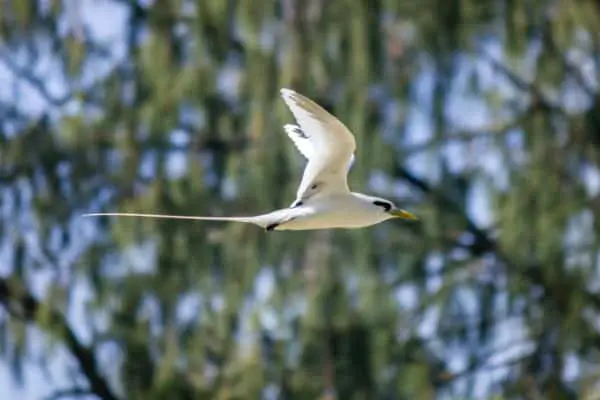Flying white-tailed tropicbird | image by kansasphoto via Flickr | CC BY 2.0
Common Name: White-tailed Tropicbird
Scientific Name: (Phaethon lepturus)| Size | Diet | Range in Hawaii | Status in Hawaii |
|---|---|---|---|
| 35 in. - 39 in. | fish and squid | Kaua'i, Moloka'i, Maui, O'ahu, and Lana'i | Least Concern |
The White-tailed Tropicbird (Phaethon lepturus) is a stunning and graceful seabird that is known for its long, white tail feathers and distinctive red bill. With its aerial acrobatics and striking appearance, this tropicbird is a beloved sight in its natural habitat.
In Hawaii, the White-tailed Tropicbird is an indigenous species and a breeding visitor, known locally as the Koa’e Kea. In this article, we’ll explore the fascinating world of the White-tailed Tropicbird and learn more about its presence in Hawaii.
White-tailed Tropicbird
Appearance

The White-tailed Tropicbird is a beautiful seabird known for its elegant appearance and graceful flight. It has a predominantly white plumage, with long, slender wings that showcase striking black markings at the tips. The bird’s most distinctive feature is its elongated tail, which is white with two elongated central feathers that trail behind in a tapering fashion, giving it the “white-tailed” name.
The White-tailed Tropicbird has a streamlined body, measuring approximately 35 to 39 inches (90 to 100 cm) in length from the tip of its beak to the end of its tail. Its wingspan can reach up to 43 to 49 inches (110 to 125 cm), allowing it to effortlessly glide over the ocean surface.
Additionally, this species exhibits a sharp, bright red bill and striking black markings around its eyes. During courtship displays, the White-tailed Tropicbird’s elongated white tail feathers are raised and fanned out dramatically, creating a mesmerizing sight as it soars above the ocean waves.
Diet
The White-tailed Tropicbird has a diet primarily composed of fish and squid, which it catches by plunge-diving into the ocean from great heights. As a skilled aerial hunter, it scans the water surface for its prey while in flight and then makes rapid dives to capture its meals.
These tropicbirds are especially adept at locating and catching small fish near the ocean’s surface, using their sharp eyesight to spot movement or disturbances in the water. They are known to feed on a variety of fish species, including flying fish, mackerel, and other small pelagic fish found in their coastal and offshore habitats.
In addition to fish, White-tailed Tropicbirds also consume squid, which they catch using similar diving techniques. Squid provide an important food source for these birds and offer a more substantial meal due to their larger size compared to fish.
Nesting
White-tailed Tropicbirds are renowned for their unique nesting habits. They typically choose remote and inaccessible locations on cliffs or steep rocky outcrops for their nesting sites. These locations offer protection from predators and human disturbance, allowing the tropicbirds to raise their young undisturbed.
The nesting season of White-tailed Tropicbirds varies depending on their geographic location, but it generally occurs during the spring and summer months. They form monogamous pairs, and both male and female birds actively participate in nest building. They construct their nests using grasses, twigs, leaves, and other vegetation they find in their surroundings. The nests are relatively simple, shallow structures with a slight depression in the center to cradle the eggs.
One distinguishing feature of White-tailed Tropicbird nests is the lack of a solid nest structure. Instead, they create nests that are often just loose piles of vegetation, sometimes even lacking a discernible nest cup. This adaptation allows better airflow around the eggs and prevents heat retention, as the tropical environments where they nest can be quite warm.
After the nest is constructed, the female typically lays a single egg, which is incubated by both parents. The incubation period lasts for about 40 to 46 days, during which the parents take turns to ensure the egg is kept warm and protected. Once the egg hatches, the parents continue to share the responsibilities of feeding and caring for the chick.
The chick remains in the nest for several months, gradually growing and developing its flight feathers. During this time, the parents provide regurgitated fish and squid as food for their offspring. When the chick is ready, it will fledge and take its first flight, leaving the nest to explore the open ocean.
Behavior

The White-tailed Tropicbird is a seabird known for its remarkable behaviors. With its long, slender wings, it effortlessly soars through the air, demonstrating agility and precision. It employs the technique of plunge diving, folding its wings back and diving headfirst into the water to capture fish and squid near the ocean’s surface.
During the breeding season, White-tailed Tropicbirds engage in elaborate courtship displays, soaring to great heights while showcasing their long tail feathers and emitting distinctive calls. They form monogamous pairs and actively participate in nest building, incubation, and chick-rearing.
These seabirds often nest in large colonies on remote islands and coastal cliffs, benefiting from protection and shared knowledge. Vocalizations play a crucial role in their communication, facilitating territory establishment, mate selection, and colony coordination.
Outside of the breeding season, White-tailed Tropicbirds exhibit nomadic behavior, undertaking long-distance journeys across the open ocean. These diverse behaviors contribute to the adaptability and survival of this fascinating seabird species.
Habitat
The White-tailed Tropicbird is a species that inhabits a range of tropical and subtropical regions around the world. It is commonly found in areas with warm oceanic waters, such as islands, coastlines, and atolls. These birds prefer nesting in remote and secluded locations, often choosing steep cliffs, rocky outcrops, or dense vegetation for their nests.
White-tailed Tropicbirds are well adapted to a marine lifestyle, spending most of their time over the open ocean. They are frequently seen in offshore waters, particularly in areas with upwellings or where currents converge, as these locations provide abundant food sources. While they primarily forage and hunt near the water’s surface, they can venture further out to sea in search of prey.
Their preferred habitats often include islands with little human disturbance, as well as uninhabited or protected areas. These locations provide essential breeding sites and reduce the risk of disturbance or predation to their nests and young. Examples of suitable habitats for White-tailed Tropicbirds include tropical islands in the Pacific, Indian, and Atlantic Oceans.
The specific habitat requirements of White-tailed Tropicbirds may vary slightly across their range. Some populations may inhabit coastal regions with rugged cliffs and rocky shores, while others may frequent more remote and isolated islands. However, the consistent element in their habitat preference is the availability of suitable nesting sites and access to abundant marine food sources.
Range
The White-tailed Tropicbird has a notable breeding range in the Southeastern Hawaiian Islands, including Kaua’i, Moloka’i, Maui, O’ahu, and Lana’i. They also have an incipient breeding population on Midway Atoll in the Northwestern Hawaiian Islands. These islands provide suitable nesting sites and habitats for the species, contributing to their presence and conservation in Hawaii.
Conservation Status

The conservation status of the White-tailed Tropicbird is generally considered to be of least concern. The species has a wide distribution across tropical and subtropical regions, including the Hawaiian Islands. However, specific conservation efforts and monitoring are important to ensure the long-term well-being of the populations.
Interesting Facts
1. Aerodynamic design
Their long, pointed wings and streamlined body shape are well-suited for their aerial lifestyle. These adaptations allow them to be excellent fliers, capable of soaring and maneuvering effortlessly through the air.
2. Lengthy tail feathers
he white tail feathers of the White-tailed Tropicbird can be remarkably long, sometimes exceeding the length of the bird’s body. These impressive tail streamers play a role in courtship displays and are used to attract mates.
3. Nomadic lifestyle
Outside of the breeding season, White-tailed Tropicbirds are highly nomadic and can travel over large distances in search of food. They are known to undertake extensive foraging flights, sometimes reaching hundreds of kilometers from their breeding grounds.
4. Cliff nesters
White-tailed Tropicbirds prefer to nest on islands with steep cliffs or large trees. They construct their nests in crevices, burrows, or on rocky ledges. These nesting sites provide protection from predators and are usually located near the sea.
Frequently Asked Questions
1. How long do White-tailed Tropicbirds live?
The average lifespan of White-tailed Tropicbirds in the wild is around 20 years. However, some individuals have been known to live longer, reaching up to 30 years.
2. Are White-tailed Tropicbirds noisy?
White-tailed Tropicbirds are relatively silent compared to other seabird species. They produce soft chirping and clicking sounds, especially during courtship and territorial displays.
3. Are White-tailed Tropicbirds social birds?
White-tailed Tropicbirds are generally solitary birds, except during the breeding season when they form pairs. They are not highly social and tend to maintain their own territories.
4. Can White-tailed Tropicbirds be kept as pets?
It is not recommended to keep White-tailed Tropicbirds as pets. They are wild birds and have specific habitat and dietary requirements that are challenging to meet in a domestic setting. Additionally, keeping them as pets may be illegal in many regions.




